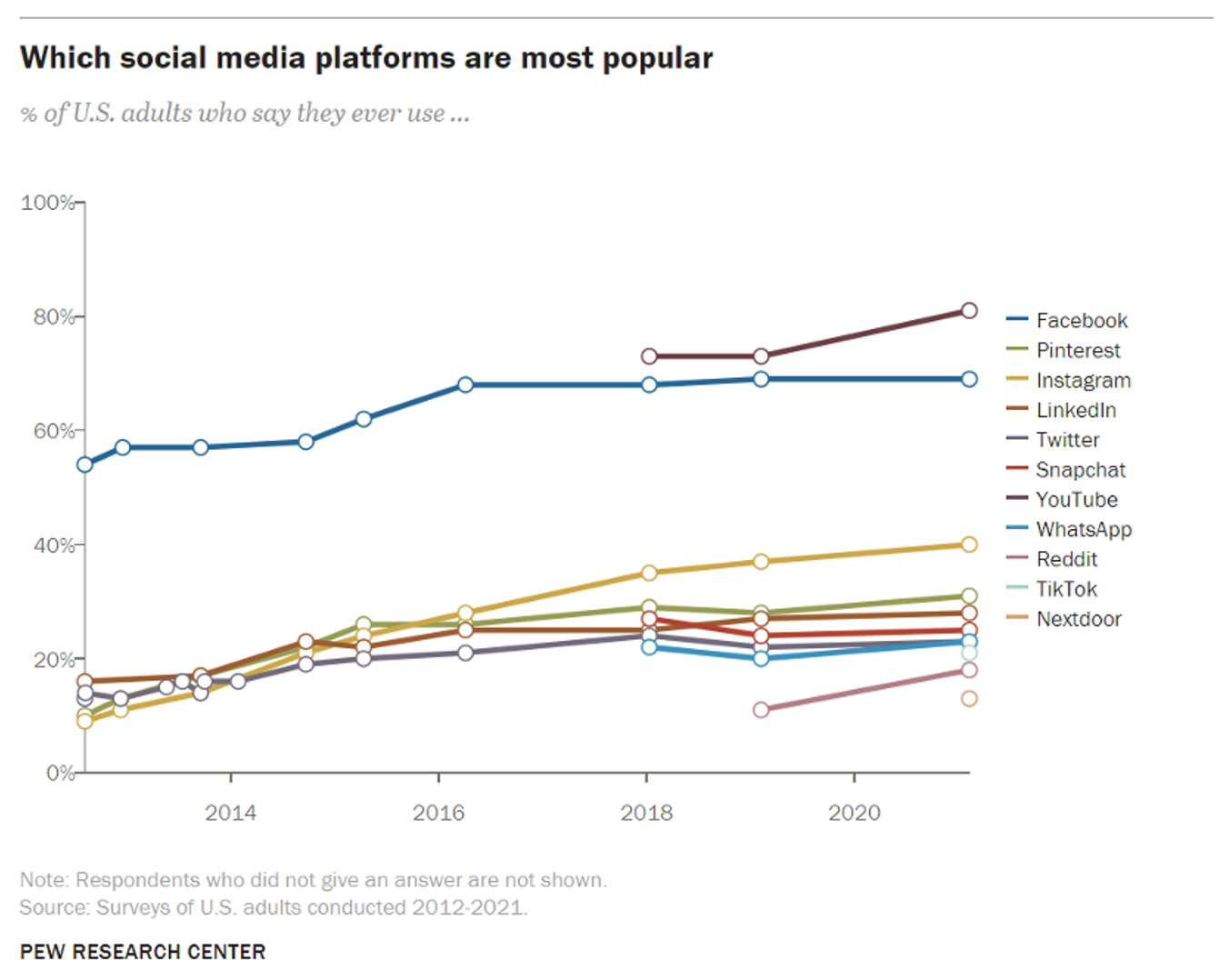Do you have any friends who aren’t on social media? In fact, can you think of any businesses that don’t have a social media page?
If you do, they are a statistical anomaly at this point. As of January 2023, there were 5.16 billion internet users worldwide, which is 64.4% of the global population. Out of this total, 4.76 billion, or 59.4% of the world's population, were social media users. With more than half the world using social media, it's clear that any comprehensive marketing strategy needs to include social media as a crucial component.
Take a look at the numbers below; they reveal the relevance and requirements of social media and targeted ads on digital platforms.
Social media recently overtook paid search as an advertising channel, growing 25% YoY and exceeding $137 billion (over search’s $135 billion)
More consumers report finding the perfect product by seeing a targeted ad (49%) over an organic post by a brand (40%)
Total spend on social media advertising is projected to reach $268 billion in 2023
Considering these statistics, it becomes clear that implementing a social media marketing strategy is crucial for long-term business success. This raises the important question: How can you create a social media strategy from the ground up?
That's precisely what this article aims to address. Let's begin!
What is a social media marketing strategy?
A social media strategy is a comprehensive plan that outlines the goals, tactics, content, and actions a brand or individual intends to take to achieve specific marketing objectives using the best social media platforms. It involves a systematic approach to leveraging social media channels to build brand awareness, engage with the audience, drive traffic, and achieve marketing goals.
How to build a social media strategy plan in 11 steps?
Here are step-by-step instructions on how you can get started.
Step 1: Set goals that work for your business
Step 2: Decide upon the metrics to track
Step 3: Study your target audience (be a little obsessed about them)
Step 4: Fill out your social profiles completely
Step 5: Decide on your marketing tone and narrative, and stick to it
Step 6: Study your competitors
Step 7: Lead with relevant content
Step 8: Double down on authenticity
Step 9: Watch your timing like a hawk
Step 10: Monitor results… and focus on the wins
Step 11: Adjust your social media strategy
Step #1: Set goals that work for your business
Have you heard of S.M.A.R.T.? It stands for specific, measurable, attainable, relevant, and time-bound. When setting your social media goals, these are excellent qualifiers to keep in mind.
Your goals should be directly relevant to your business and your domain. More importantly, you should be able to track them with the right (uncomplicated) metrics. A social media strategy holds value when it delivers measurable and trackable outcomes.
Common goals businesses look to achieve using a social media marketing strategy include:
Increasing brand awareness
Increasing community engagement
Creating sustained trust and excitement around the brand’s products
You’ll also have to keep an eye out for challenges such as:
Finding the right talent to expand your social identity
Proving ROI on your proposed tactics
Executing a comprehensive social media strategy across multiple platforms
Transforming social media into a robust business function
When setting your social media goals, ensure that each of them is clear, easily explainable, and trackable — because your managers and stakeholders will expect them to be so.
Step #2: Decide upon the metrics to track
The number of followers and likes might seem like the be-all and end-all metric you should go after, but they don’t demonstrate tangible business value. To capture how well your brand posts resonate with social media users, look for numbers on engagement, click-through rates, and conversion.
Different social platforms also require you to track different metrics. For example, it makes sense to monitor cost-per-click (CPC) on Facebook, click-through rates (CTR) on LinkedIn and story views on Instagram.
Whatever metrics you end up tracking should inform your marketing goals and how you (and your team) can reach the desired milestones. They must provide clear, relevant information on the ROI of your investment (time, effort, money) in social media marketing.
That's why learning social media metrics is important!
Step #3: Study your target audience
Get to know everything that you can (legally) about your social media audience. They are people with real wants, needs, and desires. By understanding and tapping into these aspects, you can connect with the people who will ultimately contribute to your social media success.
At the very least, you should know the following about a significant number of your social media audience:
Their average age
Their location
Their profession
Their average income (based on their profession and location)
Their primary interests (as reflected on their social media accounts)


Don’t forget to dive into your social media analytics for audience data. In particular, you can learn where they live when they are active, and how they engage with your brand on social media. This information alone can help you craft messages that will resonate with most of your audiences. One of the reasons, studying your audience is important to creating an effective social media strategy.
Step #4: Fill out your social profiles completely
When it comes to the basics of social media marketing strategy, create your brand’s social media accounts, and fill in everything required on each profile – profile photo, cover photo, bio, and images. Visit each profile to ensure that the information and images are professional and always up-to-date. This is the least your customers expect in terms of professionalism and authenticity.
Social media success is driven by engaging visuals and text. Keep those consistent across platforms — your profile image should be the same on Facebook and X, formerly Twitter, for example.
With regard to text, pay attention to your Bio/About Us section; keep it brief and include only relevant information:
Your primary offerings (products and/or services)
Your location (and the areas you cater/deliver to)
Your incentives for the audience (discount on first purchase, etc.)
Keep your language personal but refrain from using an overly informal tone. Your audience knows you’re here to make a sale, so communicate directly about how your offerings can benefit them.
Step #5: Decide on your marketing tone and narrative, and stick to it
Once you’ve set up your brand pages on social platforms, don’t start posting right away. First, establish a consistent voice and tone for your social media posts as an integral part of your overall social media strategy.
Take some time to create marketing personas for your audience. Look at their primary attributes — How old are they? Where are they from? What do they like? — and craft a public persona for your brand that resonates with them.
To ease the process, try asking yourself (and your team) the following questions:
If your brand was a person, what personality traits would they have?
What personality traits would they NOT have?
How would that person talk to/interact with customers?
What are your competitors’ brand personalities like? How can yours be better than theirs?
What impression do you want your customers to have of your brand following a social media interaction? Do you aim for them to perceive your brand as a friend, a mentor, or a caring uncle?
Once you answer these questions, you’ll get a good sense of the persona your brand wants to project, which will help you come up with powerful and meaningful content for your social posts.
Learn More: 7 Social media campaign examples for inspiration
Step #6: Study your social media competitors
Analyze what your competitors post on their social media accounts, especially the posts that work well for them. Chances are, that’s what your audience expects and therefore you should take inspiration from those posts when devising your social media marketing strategy.
Additionally, if competitors are focused on one platform more than others, try to build your own niche following on the platforms where they don’t have a dedicated audience. For example, if they are focused on Facebook, you can target X, formerly Twitter.
Try leveraging social listening as well. Research your competitors’ social accounts and the relevant keywords they target on social media.
It’s important to stay on top of new social media trends [2024] that may impact your industry. If your competitors catch on before you do, you lose the advantage of being an early adopter. At the same time, if you are uncertain about a particular trend, it is advisable to monitor its success (or lack thereof) among your competitors.
Bonus Tip: Keep an eye out for the recent winners of The Facebook Awards or The Shorty Awards. These brands have garnered significant attention within the industry and are recognized as undisputed leaders in the realm of social media.
Step #7: Lead with relevant content
Always add value – this should be the mantra around how you build your social media content and its strategy. Yes, the intent of social media content (and all marketing content) is to lead customers down the sales funnel to make a purchase. But that doesn’t mean your content cannot add (real) value to your customers’ lives.
For example, let’s say you’re selling software that helps track down electronic devices like smartphones and laptops if they go missing. To drive home the importance of such software, you can create content around actual statistics of missing and recovered gadgets.
In this case, you’re not trying just to push folks to buy something. You’re giving them solid, accurate information to help them decide how urgently they need a tracer like the one you’re selling.
Quick Tip: Try out the 80-20 rule. 80% of your posts should inform, educate, or entertain your audience. 20% should directly promote your brand.
Whatever your brand, product offerings, or domain, prioritize the publication of educational content. Start by providing knowledge that can help customers in their daily lives, information that helps them lead easier, healthier, and/or more productive lives. To help them understand why your product is essential, start by analyzing the world in which you are necessary, i.e., your industry or field of expertise.
By the time you pitch your product, a customer should be reasonably convinced about your authority within your domain. Why else would they even consider looking at what you’re selling?
If you are a beginner, we have a comprehensive guide for you on social media content creation.
Never sacrifice content relevance
Sometimes, it’s worth looking outside your industry for ideas, but you’ll have to be cautious. If your content is not immediately relevant to your audience, you will lose their attention. In today's digital landscape, customers who are well-versed in navigating the internet have an abundance of options and countless brands vying for their attention. It's crucial to understand that certain tactics, such as attempting to make "unboxing videos" relevant in the B2B world, may not resonate with this audience and could result in them disengaging from your brand.
Here’s what relevance looks like on social media:
Blogs, thought leadership pieces, news, and deep-dive content for a B2B SaaS audience.
Meticulously shot photographs of your products and/or customers showing off your products online. Celebrity endorsements are also a viable option.
Put out consistent updates on your infrastructure’s security status, as well as numbers on data breaches around the world.
Step #8: Double down on authenticity
As you decide what type of content to use, you will also need to define your social media strategy on 'authenticity'. There’s a filter for everything these days. Your customers know when a brand is capitalizing a “buzzword” just to appear relevant without really adding value to the conversation.
Before putting yourself on social media, ensure that you know why you should have a voice out there.
What is your prime differentiator?
What can you do better than everyone else?
Why should customers trust you with their wallets and businesses?
Once you have these answers, you’ll know how to stand out to your audience. Sure, you’ll be using catchy copy and alluring imagery, but it should directly connect to your key values and offerings. Don’t promise anything you cannot provide, and don’t take on a competitor directly unless you have the numbers to defend every fact.
Step #9: Watch your timing like a hawk
What good will posting on Instagram at 3 in the morning do when almost your entire audience is fast asleep? Social media marketing success hinges almost entirely on timing. You can publish the most humorous content in the world, but your effort will yield zero returns if your audience isn’t “on” to see it.
So, when do you post? That depends on who your audience is.
Social media analytics will give you insight into when your audience is awake and where they are in the world. Put together a content calendar with posts, and utilize a tool that posts at specified times automatically. Pay attention to the optimal times for engagement because that is when your audience will be most responsive to your posts. It is critical to engage with users immediately after posting.
Additionally, ensure that your brand is available to interact with audiences at these times. If someone leaves a comment, your team should respond with an answer within minutes (ideally). Try not to post at times when your team isn’t available because an unengaged user doesn’t usually translate to a happy customer. The majority of your consumers expect a response within 24 hours, and it’s a promise that, if made, should never be broken. Of course, you can schedule posts during those hours using Sprinklr’s social media automation solutions, which allow you to set up automated responses for customers when your team is offline. This helps maintain a healthy SLA and prevents your audience from getting annoyed due to a lack of engagement.
Step #10: Monitor results… and focus on the wins
There are many tools, such as Sprinklr Social, that will help you stay on top of your social media numbers. Look at web traffic — how many people come to your site or blog from your social media pages? Engagement numbers, such as likes and comments, are also obvious metrics.
You can use social media data analytics to look for specific topics and keywords customers are particularly interested in. Once you understand what gets more eyeballs and the conversation going, you can offer more of the same while optimizing lower-performing topics, posts, and ideas.
Once you have those numbers, you can use Sprinklr Insights’s integrated social listening features, AI-based conversation suggestions & integrated bots across 35+ digital channels. Moreover, using your understanding of customer preferences and addressing their pain points, you can naturally promote the adoption of your products and services through meaningful conversations—all managed from a single dashboard.
Focus on analyzing average traffic and post-performance metrics, and use this data to make necessary adjustments, realign goals, and prioritize improvements.
Step #11: Adjust your social media strategy
Once the initial results are obtained, analyze them and adjust your tactics accordingly. However, remember that social media success, like any other endeavor, does not occur overnight. It takes time to cultivate a loyal following, establish your brand voice, and witness a rise in engagement levels.
You’ll also have to experiment with placing platform-specific content on different social channels. Some audiences respond better to hashtags, while others prefer case studies and customer reports.
The whole point of tracking post views, interactions, audience timings, and demographics is to give you adequate data to make course corrections. Eventually, you’ll hit the right balance of what users like, what messages serve your brand, and what strategies nurture both seamlessly.
Simplify social media strategy with Sprinkr Social
Staying aware of every customer interaction on every social channel, including chat and messaging, is no easy task, especially if you are building your brand. At that point, you are juggling strategy ideation, execution, monitoring, and optimization. Constantly scanning social media to view updated numbers and engage with every comment and query is not something your team can do manually, at least not with the high efficiency levels you need to stay ahead in 2023 (and beyond).
Sprinklr Social simplifies and streamlines all of these processes, taking the pressure of grunt work off your shoulders. At its core, it lets you be present and engage with audiences across every digital channel. You can deliver engaging experiences on every channel from a single, unified dashboard.
At a high level, you get the following 360-degree features with Sprinklr Social:
Pre-built with OpenAI's ChatGPT, which lets you leverage AI-driven chat suggestions
Enables interaction with customers across 35+ social and messaging channels
Provides integrated listening capabilities to identify, analyze, and engage in relevant conversations that may not directly involve your brand but present opportunities to demonstrate thought leadership
AI-driven automated inbound triaging that allows you to categorize messages by intent; you’ll know which conversation to prioritize for engagement
Track brand content from development through deployment across all digital channels — and enable cross-team social media collaboration and visibility every step of the way — on a single platform
Account-level permissions and governance to ensure proper controls are in place, preventing PR crises and the publication of content that violates brand guidelines
Filters to implement a global compliance framework for approvals, governance rules, and moderation processes
Once you’ve implemented your social media strategy, Sprinklr Social helps you monitor activity on all platforms, target engageable conversations, and increase the productivity of your social media managers.






![Top 7 Social Media Analytics Tools [Best Rated 2024]](https://images.ctfassets.net/ukazlt65o6hl/7mLkeDCVdRAk3C3KJge1bc/de19f72d38dd1dcb264f4ce349d40acc/blog_banner_social_media.jpeg?w=1000&h=607&fl=progressive&q=70&fm=jpg)